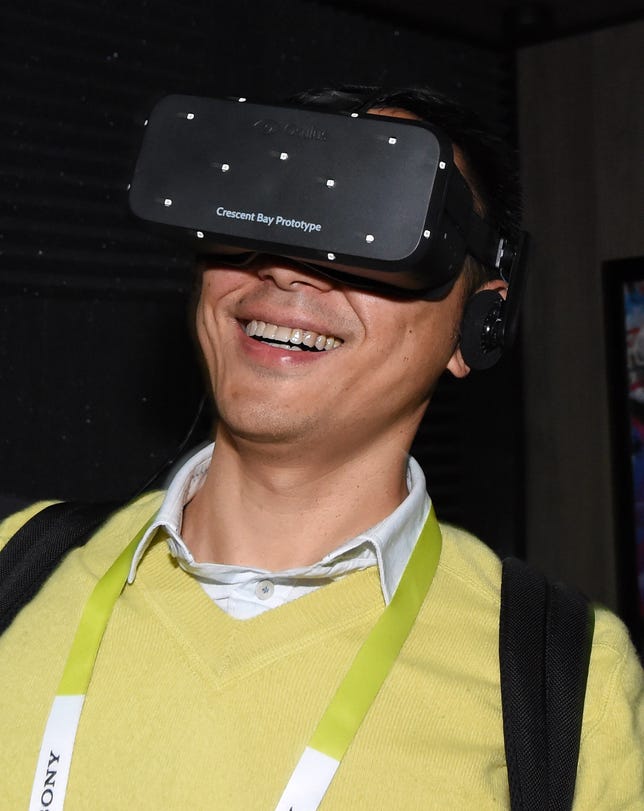
Ethan Miller, Getty Images
Oculus VR, with its innovative wrap-around Oculus Rift headset, has been a pioneer in the virtual-reality video game realm. But now the Facebook-owned startup is also looking to take on Hollywood.
Oculus VR on Monday unveiled a new subsidiary called Oculus Story Studio at the Sundance Film Festival in Park City, Utah. The studio will be tasked with producing movies in virtual reality. To kick things off, Oculus on Monday night will showcase its first production, a five-minute animated short called “Lost.”
Since its founding in 2012, Oculus has been one of the more ballyhooed virtual-reality companies, due in large part to the $2.4 million it raised via crowdfunding and heavy backing from prominent Silicon Valley venture capitalist Andreessen Horowitz. Oculus Rift, has been viewed as a major leap forward for virtual-reality devices, which have had their fair share of issues in visual fidelity over the last couple of decades.
However, the Rift has been pitched so far as a gaming product. On Oculus’ own website, the company showcases how gaming can be enhanced with the Rift with little mention of anything else.
The addition of films, however, may be due to a slight change in philosophy on the part of the company’s owner, Facebook. The world’s largest social network acquired Oculus last year for $2 billion. When Facebook announced the deal, its CEO Mark Zuckerberg said that he could see Oculus doing much more than gaming, adding that he believed it could play a crucial role in virtual reality across medicine, education and other industries.
Months later, Oculus built its own video-watching program for the Rift, called Oculus Cinema. The app places the user in a virtual movie theater. As he or she looks around, the user will see walls, other seats and a giant movie screen in front of them. In an interview with CNET last year, Oculus mobile chief Max Cohen said that his company’s “goal is to seed the ecosystem with the ability to take existing content and movies and put it into (a) nice VR environment.”
That said, the main issue for any virtual-reality device maker is getting content. Several Hollywood studios have signaled they would consider jumping into the virtual-reality market and some have already begun researching the technology. Still, no studios have actually made the leap to ready their entire catalogs for virtual reality.
Oculus has about 10 people on its film studio team, including folks who have worked at Pixar Animation Studios and Lucasfilm. It could start easy, producing movies that simply play on the aforementioned virtual screen. A more ambitious goal — and one that would set apart virtual reality from traditional streaming devices — would be to immerse the viewer in the film environment, allowing them to don the headset and be “inside” the movie as it’s going on.
CNET has confirmed that creating an experience that will “immerse users inside the virtual world” is central to the Oculus vision and that will be showcased in “Lost.” The studio has little interest in creating a passive viewing experience.
With Oculus now expanding its virtual vision, it may not be long before some of its competitors do the same. Both Sony and Samsung have shown off virtual-reality headsets, with the latter partnering with Oculus on its technology. Samsung has been clear that it sees its device, Gear VR, using entertainment to immerse users in its environment, while Sony has so far clung to gaming as its chief focus. But Sony owns a film studio, so including movies wouldn’t be a major challenge.
For its part, Microsoft, which unveiled its own wearable, the HoloLens, last week, has not shown a desire to go after movies with its device. It might also be a stretch: Rather than virtual reality, Microsoft’s technology overlays 3D digital content on the real world. So while movie-streaming is technically possible, it has some limits that Oculus, Samsung, and Sony wouldn’t necessarily need to contend with.
The “Lost” short will be shown on a new device prototype, code-named “Crescent Bay,” that adds headphones to the Rift’s familiar design. The Crescent Bay prototype, which was on display at the Consumer Electronics Show this month, has a box-like viewer that sits in front of the eyes, but offers integrated headphones, which were not previously available in Development Kit 2 of the Oculus Rift. The prototype also adds new sensors to more easily track user movements.
Crescent Bay is the follow-up to Development Kit 2 and the next prototype design for the Rift.




